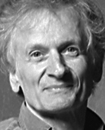
Mike Seeger
A son of composer Ruth Crawford Seeger and noted ethnomusicologist Charles Seeger, Mike Seeger also is a half-brother of Pete and brother of Peggy. Born into a musical family and weaned on field recordings of southern rural music and his parents singing of those folk songs, Seeger learned to play the autoharp at age 12. He later picked up the banjo, fiddle, guitar, mandolin and harmonica.
Now 75, Seeger has been performing and recording traditional American string music since the 1950s and can be heard on dozens of albums. Many of these were released by Folkways Records, for which he also made a number of field recordings to help preserve America’s musical traditions and folk heritage.
In mid-1958, Mike Seeger joined John Cohen and Tom Paley to form The New Lost City Ramblers, a vocal and instrumental urban folk group that helped to popularize and spark renewed interest in traditional string band music and played a major role in the 1960s folk revival as it evolved to include bluegrass and unaccompanied ballads in its repertoire. As a member of the Ramblers, Seeger played at the very first Newport Folk Festival. The New Lost City Ramblers not only based much of their music on the old-time cultural stylings of the 1920s and 1930s, but they also helped introduce traditional performers from the rural south to urban audiences and influenced a number of other musicians – including The Byrds, Ry Cooder and Bob Dylan. Seeger also was a member of Strange Creek Singers with Hazel Dickens, Alice Gerrard, Lamar Grier and Tracy Schwarz.
Along with ten other recently named 2009 NEA National Heritage Fellowship recipients, Seeger will be feted in Washington, D.C. in September during a series of events slated to include a banquet at the Library of Congress and an awards presentation on Capital Hill.

Like/Follow Us!